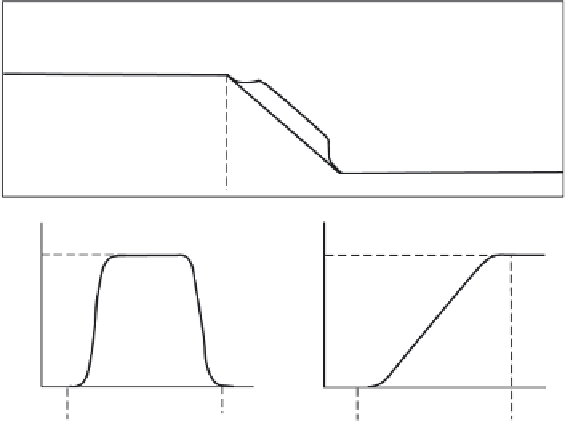Geoscience Reference
In-Depth Information
(a)
(b)
Fig. 3.8 Shape of calculation region (a). Space-time law of motion of bottom (b)
Resolution of the problem (3.4), (3.5), (3.7) and (3.34) was performed by the ex-
plicit finite-difference method on a rectangular mesh with fixed (but not identical)
horizontal and vertical steps. As the stability condition we adopted the Courant cri-
terion
z
)
c
, where
z
are the space steps.
Figures 3.9 and 3.10 show the calculated free-surface disturbance at time
moment
t
= 1
,
000 s for different depth values
H
1
and
H
2
. The displacement
duration was 10 s. Figure 3.9 corresponds to a fixed depth of the shallow-water
area,
H
1
= 0
.
5 km; here, the depth
H
2
is varied. Figure 3.10 demonstrates the re-
sults of calculations for the case of a fixed average depth of the calculation region:
the slope 'rotates' about its central point
x
= 0
,
z
=
∆
t
<
min(
∆
x
,
∆
∆
t
is the time step,
∆
x
and
∆
4
.
5 km. Practically, the wave
perturbation of the surface in all the cases consists of a slow gravitational component
and of a fast acoustic (or elastic) component.
In the case of a horizontal ocean bottom (
H
1
=
H
2
= 4
.
5 km) elastic oscillations
of the water column above the source area continue to be present for a long time.
This is due to the wave vectors retaining directions close to vertical, and the energy
of elastic oscillations slowly leaves the source area. The appearance of even a very
insignificant slope of the bottom (1:160 for
H
1
= 4
.
25 km,
H
2
= 4
.
75 km) alters
the picture drastically. In the deep part of the basin an acoustic precursor is observed
of significant amplitude, the amplitude of elastic surface oscillations in the shallow
region remains practically intact. Oscillations immediately above the source are al-
ready close to conclusion by the time moment
t
= 1
,
000 s. Further enhancement
of the slope's steepness, first, leads to a decrease in the amplitude of the acoustic
precursor in the shallow-water part of the basin, and, subsequently, to its total dis-
appearance. Hence follows the important conclusion that it is impossible to register
an acoustic precursor in shallow water, for example, by variations of the sea level.
−

































